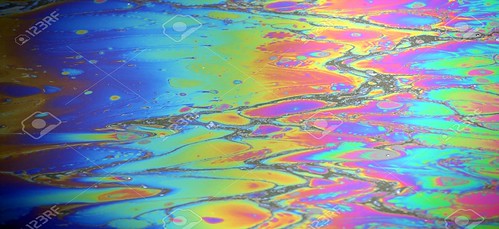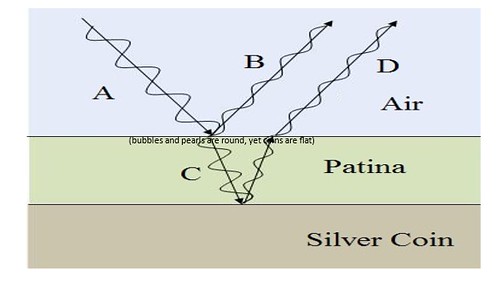
PREV ARTICLE
NEXT ARTICLE
FULL ISSUE
PREV FULL ISSUE
V25 2022 INDEX E-SYLUM ARCHIVE THOUGHTS ON IRIDESCENCEDaryl Haynor submitted these thoughts and definitions about the term iridescence in numismatics. Thanks! -Editor
Mr. Webster defines iridescence as The vocabulary term recited in last week's E-Sylum states that iridescence of numismatic items is due to a diffraction of light from flow marks, and that it is a form of mint luster. If that indeed were the case, toning enthusiasts would be searching freshly produced coins directly from the mint for rainbow beauties. Of course, that is not the case. While flow lines help to create the appearance of luster, even the highly desirable cartwheel effect, it is not flow lines, but another phenomenon that is the usual cause of iridescence on a coin. Rather than using soap bubbles or nacre as an analogy, as the vocabulary term does, conjuring an oil spill on a flat-water surface creates a better image in one's mind of how colors may appear on a coin's surface (bubbles and pearls are round, yet water (a coin) is flat). The thinnest layer of oil atop water can result in an eye-full of rainbow colors. How does this happen? While some light waves bounce off the top surfaces of the oil, other light waves are redirected as they pass from one medium to another (refraction), and bounce off the coin surface below. The upper layer of oil creates one surface, while the water level creates a second and lower surface. The combination of bounced light off the oil, and refracted light bounced off the water level converge on the human eye to create colors via what is known as thin-film interference. Thin-film interference is a natural phenomenon in which light waves reflected by the upper and lower boundaries of a thin film interfere with one another, either enhancing or reducing the reflected light. Think of the water level as the coin's surface, and the oil level equivalent to toning, or the level of interaction of a coin's surface with its environment over time (patina). As the nature, length, and depth of the environmental interaction changes, so does the level of thin film interference, thus altering the colors that the human eye perceives on a coin's surface. Iridescence does not necessarily disappear rapidly due to tarnish, as the vocabulary term states. It is actually created from, and may actually be enhanced as the level of toning advances (you say tarnish, I say toning). Of course, as patina (toning) advances on a coin, colors may become less eye appealing or cancel out altogether. Not all toning is attractive, as Mother Nature can be very fickle and she will do what she pleases.
Not to complicate matters, but it is actually a misnomer to refer to toning on a
coin as The vocabulary term for iridescence conflates how the human eye sees mint (cartwheel) luster with how it sees toning on a coin. Hopefully this helps to separate the concepts of luster and toning.
To read the earlier E-Sylum article, see:
Wayne Homren, Editor The Numismatic Bibliomania Society is a non-profit organization promoting numismatic literature. See our web site at coinbooks.org. To submit items for publication in The E-Sylum, write to the Editor at this address: whomren@gmail.com To subscribe go to: https://my.binhost.com/lists/listinfo/esylum All Rights Reserved. NBS Home Page Contact the NBS webmaster 
|


